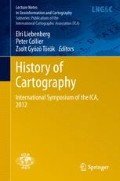Abstract
After the successful work of the military survey of the Banat in 1769–72, the Habsburg monarchy took on an even more demanding task: the systematic division of land into family plots in a huge territory representing an area of almost 28,000 km2 with approximately half a million inhabitants. The cartographers found themselves in a new position vis-à-vis the rural society and had to face the institutions of the village communities. The surveying and mapping of the land was indeed tied with a new mission: imposing on the farmers the geometric and final definition of their plots. The few cadastral maps that have been preserved in Vienna and in Budapest can be studied as the result of a complex social process involving peasant-farmers, local worthies, rural communities and cartographers over a rather long period of time. The different actors usually made arrangements between themselves, although mutual misunderstandings and conflicts occurred too. The current—and almost classical—approach to the cadastral and estates maps, whether ordered by States or private landowners, provide an interesting analytical framework. They point out the influence of the rationalising tendencies of the estates’ management and the tax system in the early modern period on this type of mapping and describe maps as a form of communication. But identifying signs of peasants’ and villages’ participation in creating the maps is more difficult than understanding the logic of power. Fortunately, the possibility of combining an analysis of iconographic sources and of the detailed reports about the local activity of the cartographers-engineers in Banat, allows overcoming this difficulty.
Access this chapter
Tax calculation will be finalised at checkout
Purchases are for personal use only
References
Bendall S (1992) Maps, land and Society: A history, with carto-bibliography of Cambrigeshire estate maps, c. 1600–1836. Cambridge University Press, Cambridge
Buisseret D (ed) (1992) Monarchs, ministers, and maps: the emergence of cartography as a tool of government in early modern Europe. University of Chicago Press, Chicago
Buisseret D (ed) (1996) Estate maps in the old and new worlds. University of Chicago Press, Chicago-London
Fodor F (1952) A magyar térképirás, 1. Budapest
Fodor F (1957) Tiszavölgy úrbéri térképei, 1773–1781, Geodézia és Kartográfia: 39–48
Harley B (1988) Maps, knowledge and power. In: Cosgrove D, Daniels S (eds) The iconography of landscape: essays on the symbolic representation, design and use of past environments. Cambridge University Press, Cambridge, pp 277–312
Kagan R, Schmidt B (2007) Maps and the early modern state: official cartography. In: Woodward D (ed) The history of cartography: cartography in the European renaissance, vol 3/1. The University Chicago Press, Chicago, pp 661–679
Kain R, Baigent E (eds) (1992) The cadastral map in the service of the state. The University Chicago Press, Chicago
Kain R (2007) Maps and rural land management in early modern Europe. In: Woodward D (ed) The history of cartography: cartography in the European renaissance, vol 3/1. The University Chicago Press, Chicago, pp 705–718
Landais B (2012) Du partage communautaire de la terre au lopin familial : Vie politique au village et réforme cadastrale dans les marges balkaniques de la monarchie des Habsbourg au XVIIIe siècle. Histoire et Sociétés Rurales: (still unpublished)
Patay P (1979) A Temesi Bánság kéziratos térképei XVIII. század első felében, Geodézia és Kartográfia 70:55–58
Plihál K (1983) Úrbéri térképek. Geodézia és Kartográfia: 195–201
Raum F, Joó I (eds) (1992) A magyar földmérés és térképészet története. Budapest
Raum F (1993) A magyarországi földmérő és térképészek fontosabb életrajzi és bibliográfiai adatai. Budapest
Zs Török (2007) Renaissance cartography in east-Central Europe, ca. 1450–1650. In: Woodward D (ed) The history of cartography: cartography in the European renaissance, vol 2/3. The University Chicago Press, Chicago, pp 1806–1851
Williams BJ (1984) Mexican pictorial cadastral registers: an analysis of the Codice de Santa Maria Asuncion and the Codex Vergara. In: Harvey HR, Prem HJ (eds) Explorations in ethnohistory: Indians of Central Mexico in the sixteenth century. University of New Mexico Press, Albuquerque, pp 103–125
Author information
Authors and Affiliations
Corresponding author
Editor information
Editors and Affiliations
Rights and permissions
Copyright information
© 2014 Springer-Verlag Berlin Heidelberg
About this chapter
Cite this chapter
Landais, B. (2014). Villages, Actors of Local Cartography? The Cadastral Maps of the Banat (1772–1779). In: Liebenberg, E., Collier, P., Török, Z. (eds) History of Cartography. Lecture Notes in Geoinformation and Cartography(). Springer, Berlin, Heidelberg. https://doi.org/10.1007/978-3-642-33317-0_8
Download citation
DOI: https://doi.org/10.1007/978-3-642-33317-0_8
Published:
Publisher Name: Springer, Berlin, Heidelberg
Print ISBN: 978-3-642-33316-3
Online ISBN: 978-3-642-33317-0
eBook Packages: Earth and Environmental ScienceEarth and Environmental Science (R0)

